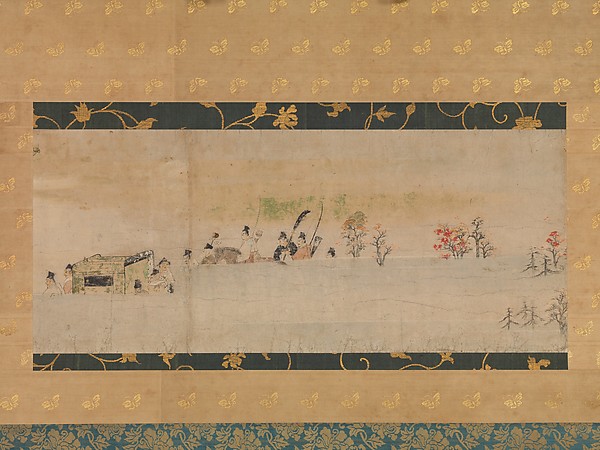
The Tale of Sumiyoshi handscroll held by The Met dates back to thirteenth century Japan. Gift of the Mary and Jackson Burke Foundation, 2015.
From rom coms to stacks of romantic paperbacks, we enjoy a good love story. For many, our first experience with a love story may have been the story of Cinderella. But the Cinderella-style story has been around since long before Disney released their famous animated version in 1950. Cinderella stories were very popular in the Heian and Kamakura periods in Japan. This artifact is an example of that – a thirteenth century illustration telling The Tale of Sumiyoshi on a beautifully drawn handscroll. The story was likely created in the tenth century by an anonymous author.
The piece of the scroll held by The Metropolitan Museum of Art in New York City tells only part of the story – the happy ending of the couple riding off in a carriage. Another portion of the scroll is in the collection of the Tokyo National Museum and tells a little more of the story. Because only fragments of the handscroll remain, there is not much left of the text of the story. A series of poems supplements the artwork of this tale, helping to fill in the gaps.
The Tale of Sumiyoshi is of Himegimi, a beautiful princess who falls in love, but of course has an evil stepmother working to foil her plans of marriage. The stepmother tricks Himegimi’s suitor into marrying one of her own daughters. Himegimi then left for the town of Sumiyoshi, where her deceased mother’s wet nurse was living. Eventually, Himegimi’s love found her there, and they were secretly married. The couple was afraid of the stepmother so they kept their relationship hidden, even after having two children. A few years later, Himegimi invited her father to a special celebration for one of her children, letting him find out about her secret marriage. The result? A happily ever after for the couple and a wicked stepmother left to live in poverty and disgrace.
Many young girls around the world are familiar with some version of this classic tale. What does the story say to them? Is it a message of caution or encouragement? The moral of the story may depend on the background of the individual. This artifact makes me wonder what a young girl in thirteenth century Japan interpreted The Tale of Sumiyoshi. Imagine hearing the poems and seeing the illustrations. Think about your own interpretation of the story and decide for yourself what message is being conveyed.
This artifact makes connections across time and space. The basic story is well known around the world and has had many different versions over several centuries. Girls from past and present have read, watched, and heard the same story in its many different formats – showing that The Tale of Sumiyoshi is timeless.
-Hillary Rose
Education Advisor
Girl Museum Inc.
This post is part of our 52 Objects in the History of Girlhood exhibition. Each week during 2017, we explore a historical object and its relation to girls’ history. Stay tuned to discover the incredible history of girls, and be sure to visit the complete exhibition to discover the integral role girls have played since the dawn of time.
